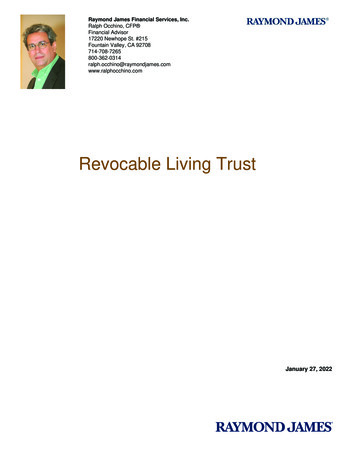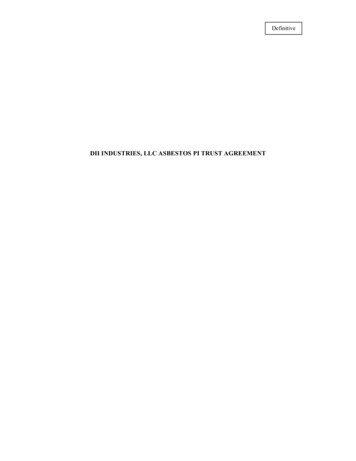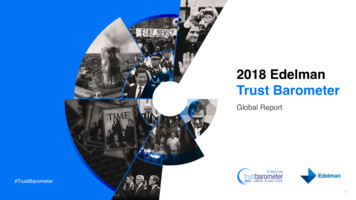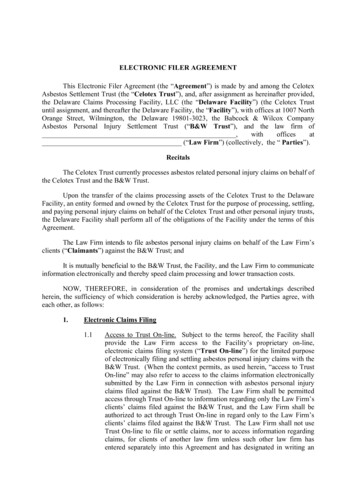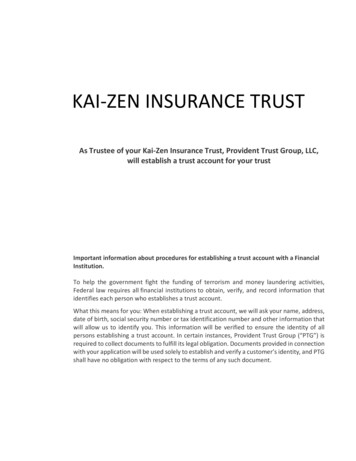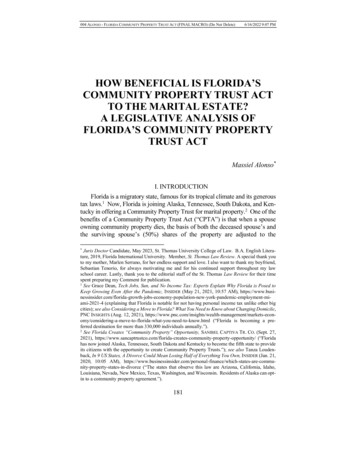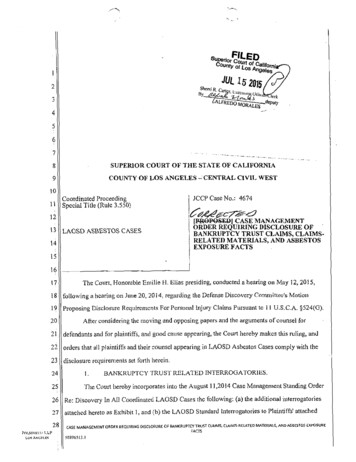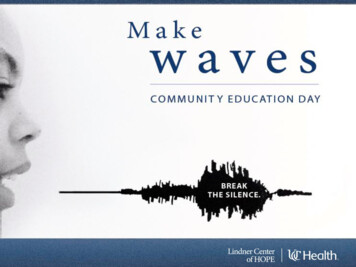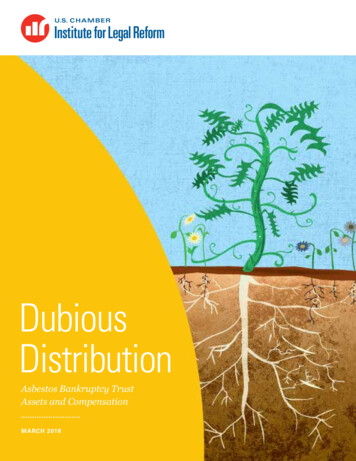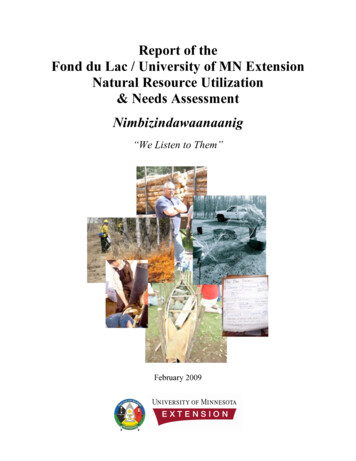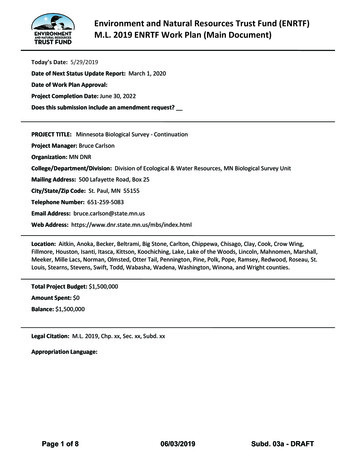
Transcription
Environment and Natural Resources Trust Fund (ENRTF)M.L. 2019 ENRTF Work Plan (Main Document)Today’s Date: 5/29/2019Date of Next Status Update Report: March 1, 2020Date of Work Plan Approval:Project Completion Date: June 30, 2022Does this submission include an amendment request?PROJECT TITLE: Minnesota Biological Survey - ContinuationProject Manager: Bruce CarlsonOrganization: MN DNRCollege/Department/Division: Division of Ecological & Water Resources, MN Biological Survey UnitMailing Address: 500 Lafayette Road, Box 25City/State/Zip Code: St. Paul, MN 55155Telephone Number: 651-259-5083Email Address: bruce.carlson@state.mn.usWeb Address: : Aitkin, Anoka, Becker, Beltrami, Big Stone, Carlton, Chippewa, Chisago, Clay, Cook, Crow Wing,Fillmore, Houston, Isanti, Itasca, Kittson, Koochiching, Lake, Lake of the Woods, Lincoln, Mahnomen, Marshall,Meeker, Mille Lacs, Norman, Olmsted, Otter Tail, Pennington, Pine, Polk, Pope, Ramsey, Redwood, Roseau, St.Louis, Stearns, Stevens, Swift, Todd, Wabasha, Wadena, Washington, Winona, and Wright counties.Total Project Budget: 1,500,000Amount Spent: 0Balance: 1,500,000Legal Citation: M.L. 2019, Chp. xx, Sec. xx, Subd. xxAppropriation Language:Page 1 of 806/03/2019Subd. 03a - DRAFT
I. PROJECT STATEMENT:The Minnesota Biological Survey (MBS) proposes to collect and deliver foundational natural resource data andinformation on native and rare species, pollinators, and native plant communities. This work will deliver newdata and products that help guide and prioritize biodiversity and water conservation and managementthroughout Minnesota.This proposal will 1) bring to completion field surveys in all of Lake of the Woods County, St. Louis County, andKoochiching County thereby completing field work for the statewide, baseline county-by-county survey startedin 1987 for native terrestrial plants, plant communities, birds, amphibians, reptiles, and small mammals; 2)continue towards statewide completion of aquatic (lake) plant surveys; 3) update and enhance 1980s–90s fieldsurveys and monitoring data in select native prairies, wetlands, and forests that are important to currentcollaborative planning and management initiatives or of imminent conservation attention; and 4) provide newbiological reports, a new book, technical guidance, and outreach resulting from 1-3 above.Recent examples of delivery and interpretation of MBS data include identification, restoration and managementof Scientific and Natural Areas; updates and revisions to Minnesota’s list of endangered, threatened and specialconcern species; development of pollinator best-management practices; site selection and seed mixdevelopment for cover crop, buffer and clean water initiatives; delivery of biological specimens for the UMN BellMuseum’s Minnesota Biodiversity Atlas (ENRTF ML18 004-A); and technical support tools for stream andwatershed management. MBS has particular ENRTF-invested expertise and capacity to efficiently and effectivelydeliver the stated outcomes.II. OVERALL PROJECT STATUS UPDATES:First Update March 1, 2020Second Update September 1, 2021Third Update March 1, 2021Fourth Update September 1, 2022Fifth Update March 1, 2022Final Report between project end (June 30) and August 15, 2022III. PROJECT ACTIVITIES AND OUTCOMES:ACTIVITY 1: County Biological Surveys – complete Lake of the Woods, St. Louis, and Koochiching CountiesDescription: MBS will bring to completion, in the three remaining counties, statewide county-by-county baselinefield surveys begun in 1987 on the distribution and ecology of native terrestrial plants, plant communities, birds,amphibians, reptiles, and small mammals.ACTIVITY 1 ENRTF BUDGET: 791,538Outcome1. Baseline field survey completed for Northwest Angle, Lake of the Woods County2. Baseline field survey completed for St. Louis County2Page 2 of 806/03/2019Completion DateJune 2021June 2021Subd. 03a - DRAFT
3. Baseline field survey completed for Koochiching County4. Field data entered into DNR databases; specimens delivered to MN repositories.June 2021OngoingACTIVITY 2: Enhance Surveys and Monitoring in High Priority Sites and Ecological SystemsDescription: Collect and deliver field survey data and provide analysis on targeted lakes, high-quality nativeplant communities, sensitive species, and pollinators that either 1) expand upon existing or previous ENRTFinvestments in data collection and analysis or 2) address foundational needs in Minnesota science andcollaborative plans and projects.ACTIVITY 2 ENRTF BUDGET: 318,462Outcome1. Statewide lake surveys continued for native and rare aquatic plants. 125 lakes in 8counties.2. Field surveys completed of newly documented prairie vegetation and rare species innorthwestern Minnesota. 200 sites in 16 counties.3. 1980s–90s field surveys updated and enhanced for rare species, pollinators, or nativevegetation in eastern Minnesota. 10 sites TBD from 26 counties.4. Field data entered into DNR databases; specimens delivered to MN repositories.Completion DateJune 2021June 2021June 2021OngoingACTIVITY 3: Deliver survey resultsDescription: Provide interpretation of results of Activities 1, 2 and 3 through products and technical assistanceto guide conservation and management of native plant communities, rare species, and ecological systems (e.g.,watersheds, sites of biodiversity significance).ACTIVITY 3 ENRTF BUDGET: 390,000Outcome1. Final draft delivered for publication of new book on ferns and fern allies ofMinnesota.2. Digital maps (GIS polygon data) created for native plant communities and sites.Targeted field surveys to address mapping questions and quality control.3. DNR’s website and social media updated with current survey results; biologicalreports, technical guidance, presentations, and trainings delivered.Completion DateJune 2021OngoingOngoingFirst Update March 1, 2020Second Update September 1, 2021Third Update March 1, 2021Fourth Update September 1, 2022Fifth Update March 1, 2022Final Report between project end (June 30) and August 15, 20223Page 3 of 806/03/2019Subd. 03a - DRAFT
IV. DISSEMINATION:Description: MBS data are stored primarily in the Division of Ecological and Water Resources informationsystems, which are increasingly linked to other databases in the MN DNR. In addition, MBS procedures, updates,recent maps, and links to related data are presented on the DNR website. Many GIS datasets are delivered toclients through the web. MBS regularly provides vegetation plot data from the relevé database to researchers atacademic institutions, other agencies and organizations. Data on rare species are available through agreementswith the requesting agency and the DNR. For data on locations or rare features, a data request form is availablevia the web: http://www.dnr.state.mn.us/nhnrp/nhis.htmlMBS publishes and distributes survey results in a variety of formats for various audiences. Many products areavailable as enterprise datasets on the DNR website, including GIS shape files of native plant communities andMBS sites, native plant community field guides, and guides to sampling techniques such as vegetation plot datacollection using the relevé method. MBS web pages are updated with new information and have links toassociated resources. http://www.dnr.state.mn.us/mbs/index.htmlThe DNR and Legislative libraries and other local information repositories (such as libraries within counties) haveaccess to published products, including books, maps, reports, field guides and digital media. MBS has publishedseveral books and field guides.Staff routinely make presentations that describe MBS methodologies and results to a wide range of audiencesincluding county boards, local planning groups, citizen advisory groups, other biologists, land managers, andstudents. MBS staff provide local planners with ecological interpretations describing important sites ofbiodiversity identified during the Survey to assist with management plans.Physical collections are deposited at Minnesota repositories, primarily at the University of Minnesota’s J.F. BellMuseum of Natural History and at the Science Museum of Minnesota, St. Paul. As part of a larger network ofmuseums and herbaria, these cooperators are essential to the documentation and sharing of MBS results. MBSand museum staff meet periodically to address curatorial, data management, and interpretive needs.MBS also delivers data through an international organization, NatureServe, and also shares data withcooperators at colleges and universities.The Minnesota Environment and Natural Resources Trust Fund (ENRTF) will be acknowledged through use of thetrust fund logo or attribution language on project print and electronic media, publications, signage, and othercommunications per the ENRTF Acknowledgement Guidelines.First Update March 1, 2020Second Update September 1, 2021Third Update March 1, 2021Fourth Update September 1, 2022Fifth Update March 1, 2022Final Report between project end (June 30) and August 15, 2022V.ADDITIONAL BUDGET INFORMATION:A. Personnel and Capital Expenditures4Page 4 of 806/03/2019Subd. 03a - DRAFT
Explanation of Capital Expenditures Greater Than 5,000: N/AExplanation of Use of Classified Staff: Any classified staff position paid for by ENRTF will either: 1) be backfilledwith a new position OR 2) the work done by this position will be delayed, eliminated, or completed by the startof the project. The activities of all or portions of the following four classified staff are directly related to thiswork program. A portion of the time of one entomologist (0.5 FTE for one year) is directed to pollinator fieldsurveys and data management in Activity 2. Due to extensive entomological field and data analysis experience,this entomologist brings knowledge and perspectives that will result in high quality results.Total Number of Full-time Equivalents (FTE) Directly Funded with this ENRTF Appropriation:Enter Total Estimated Personnel Hours for entireduration of project: 28,912Divide total personnel hours by 2,080 hours in 1 yr TOTAL FTE: 13.9Total Number of Full-time Equivalents (FTE) Estimated to Be Funded through Contracts with this ENRTFAppropriation:Enter Total Estimated Contract Personnel Hours forentire duration of project: 1664Divide total contract hours by 2,080 hours in 1 yr TOTAL FTE: 0.8VI. PROJECT PARTNERS:A. Partners outside of project manager’s organization receiving ENRTF fundingUniversity of Minnesota Press, costs for publishing of Activity 3, Outcome 1: a new book on ferns and fern alliesof Minnesota.B. Partners outside of project manager’s organization NOT receiving ENRTF fundingNameGeorge WeiblenRalph HolzenthalPhil DelphyTitleAffiliationProfessor and ScienceDirectorProfessorUMN Bell MuseumUMN Dpt. Of EntomologyEndangered SpeciesCoordinator.US Fish & Wildlife ServiceRoleBiolgical specimen curation;MN Biodiversity AtlasBiological specimencuration.Listed species coordinationand collaboration.VII. LONG-TERM- IMPLEMENTATION AND FUNDING:MBS data, analysis, products, and technical guidance have proven critical and foundational to countless societaland scientific applications. MBS is funded by ENRTF, State General Fund, State Fish & Game Fund, StateHeritage Enhancement Fund, and Federal State Wildlife Action Plan dollars. DNR is developing new strategies tosustainably fund MBS. MBS has developed a 10-year strategic plan to guide work and funding priorities through2018. MBS will continue to offer LCCMR proposals that address relevant needs and add value to existing ENRTFinvestments, including completion of statewide baseline biological surveys; species and ecosystem monitoring;product development (e.g., books, maps); targeted field surveys to inform conservation and managementplanning and decisions; and field surveys for under-surveyed taxa and ecological systems.VIII. REPORTING REQUIREMENTS: Project status update reports will be submitted March 1 and September 1 each year of the projectA final report and associated products will be submitted between June 30 and August 31, 20225Page 5 of 806/03/2019Subd. 03a - DRAFT
Attachment A:Environment and Natural Resources Trust FundM.L. 2019 Budget SpreadsheetLegal Citation:Project Manager: Bruce CarlsonProject Title: Minnesota Biological SurveyOrganization: Minnesota Department of Natural ResourcesProject Budget: 1,500,000Project Length and Completion Date: 3 years, June 30, 2022Today's Date: 8/27/2018ENVIRONMENT AND NATURAL RESOURCES TRUST FUND BUDGETBUDGET ITEMPersonnel (Wages and Benefits)Botanist 83,691 (82% salary, 18% benefits) 0.5 FTE for two yearsPlant Ecologists 918,733 (position #1 72% salary, 28% benefits; positions #2 and #3 66% salary, 34%benefits; position # 4 76% salary, 24% benefits; positions #5 71% salary, 29% benefits) 5.0 FTEs for twoyearsEntomologist/Pollination Specialist 35,387 (71% salary, 29% benefits) 0.25 FTE for two yearsData/Specimen Assistant 38,189 (63% salary, 37% benefits) 0.2 FTE for two yearsProject/Data Coordinator 80,026 (59% salary, 41% benefits) 1.0 FTE for one yearInformation officer 98,251 (64% salary 36% benefits) 0.5 FTE for two years.Professional/Technical/Service ContractsMN.IT for embedded GIS services (equivalent to 0.4FTE for each of 2 years)Joint Powers Agreement with University of Minnesota Press for book publicationEquipment/Tools/SuppliesEquipment is used from previous survey periods when at all possible (e.g. GPS units, cameras, canoes,communication equipment, etc.) but replaced, repaired, or updated as necessary. Items such asbatteries, specimen collecting materials, aerial photography need to be replaced or updated each fieldseason.Travel expenses in MinnesotaTravel expenses for MN travel related to field survey in Acitivies 1 & 2. Travel expenses are subject toState of MN labor agreements and DNR policy. Food ( 15,000), transportation in seasonal DNR fleetvehicles ( 35,000), and lodging ( 25,000).OtherDirect and Necessary: DNR’s direct and necessary costs pay for activities that are directly related to andnecessary for accomplishing appropriated projects. HR Support ( 20,537), Safety Support ( 4,254),Financial Support ( 17,110), Communication Support ( 1,251), IT Support ( 46,513), and PlanningSupport ( 1,059).COLUMN TOTALOTHER FUNDS CONTRIBUTED TO THE PROJECTNon‐State:Federal ‐ State Wildlife Grants FY20 and FY21State:General Fund FY20 and FY21Heritage Enhancement FY20 and FY21In kind: N/APAST AND CURRENT ENRTF APPROPRIATIONSCurrent appropriation:ML2017 ‐ MN Biological SurveyPast appropriations:ML2015 ‐ MN Biological SurveyML2013 ‐ MN County Biological SurveyML2011 ‐ MN County Biological SurveyML2009 ‐ MN County Biological SurveyML2007 ‐ MN County Biological SurveyML2005 ‐ MN County Biological SurveyML2003 ‐ MN County Biological SurveyML2001 ‐ MN County Biological SurveyML1999 ‐ MN County Biological SurveyML1997 ‐ MN County Biological SurveyML1995 ‐ MN County Biological SurveyML1993 ‐ MN County Biological SurveyML1991 ‐ MN County Biological SurveyPage 6 of 8BudgetAmount SpentBalance 1,254,276 ‐ 1,254,276 60,00015,000 ‐ ‐ 60,00015,000 5,000 ‐ 5,000 75,000 ‐ 75,000 90,724 ‐ 90,724 1,500,000 ‐ 1,500,000Status (securedor pending)BudgetSpentBalancePending 500,000 ‐ 500,000PendingPending 500,000600,000‐ ‐ ‐ ‐ 500,000600,000‐Amount legallyobligated but notyet spent 1,728,878 udget Spent2,900,000 1,000,000 Balance1,171,122 1,000,000 bd. 03a - DRAFT
Minnesota Biological Survey-ContinuationKITTSONROSEAULAKEOF EDLAKEPOLKLAKEST. LOUISLAKELakeCLEARWATERCOOKST. ECKERAITKINWADENAWILKINCARLTONCROW WINGOTTER TAILfor2ActivityPINETODDGRANTDOUGLASMORRISONMILLE LACSKANABECTRAVERSESTEVENSBENTONPOPESTEARNSBIG STONECHISAGOCHIPPEWALAC QUI PARLEHENNEPINRAMSEYLake surveys for native and rare aquatic plantsMCLEODRENVILLEYELLOW MEDICINEEnhance Surveys and Monitoring in HighPriority Sites and Ecological SystemsForest and wetland surveys for rare species,pollinators, line surveycompleted by 2021Prairie surveys of undocumented native vegetationand rare speciesISANTISHERBURNESWIFTCounty Biological COLLETRICELE FILLMOREHOUSTONInterpret and Deliver Survey ResultsPage 7 of 806/03/2019Subd. 03a - DRAFT
Page 8 of 806/03/2019Subd. 03a - DRAFT
Physical collections are deposited at Minnesota repositories, primarily at the University of Minnesota's J.F. Bell . Museum of Natural History and at the Science Museum of Minnesota, St. Paul. As part of a larger network of museums and herbaria, these cooperators are essential to the documentation and sharing of MBS results. MBS
